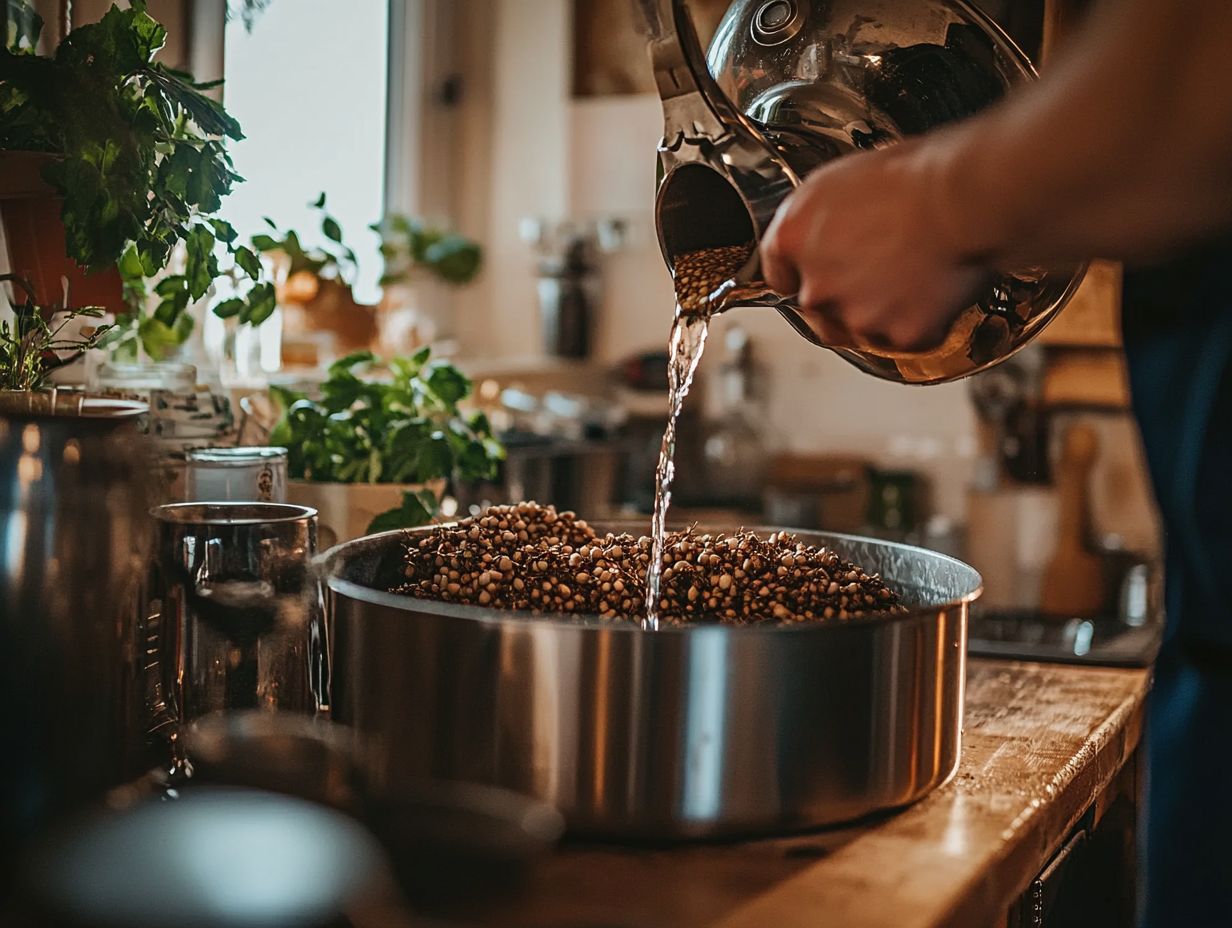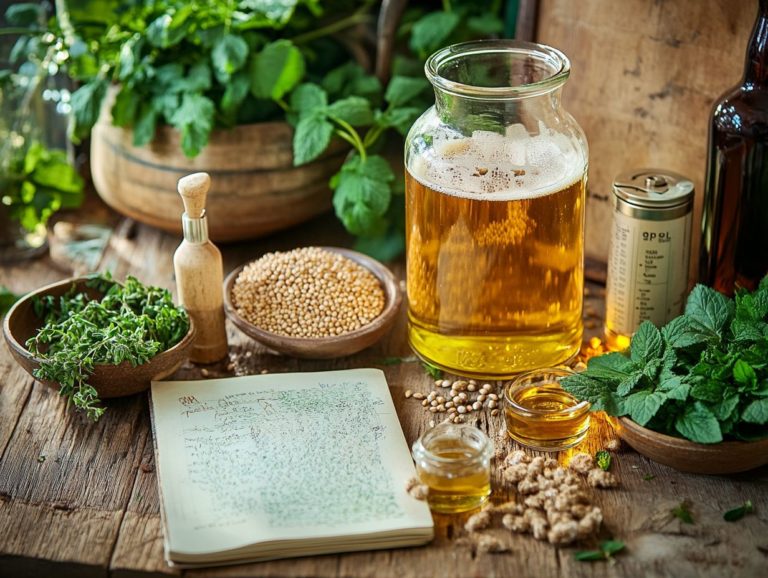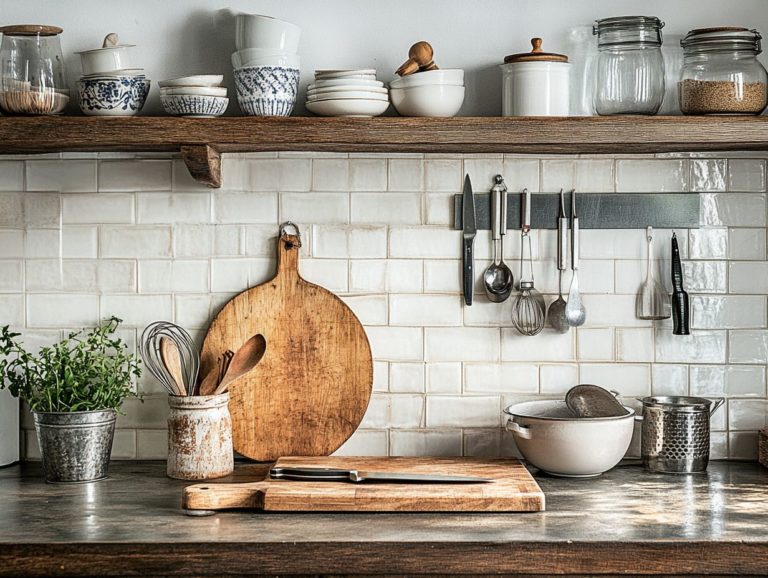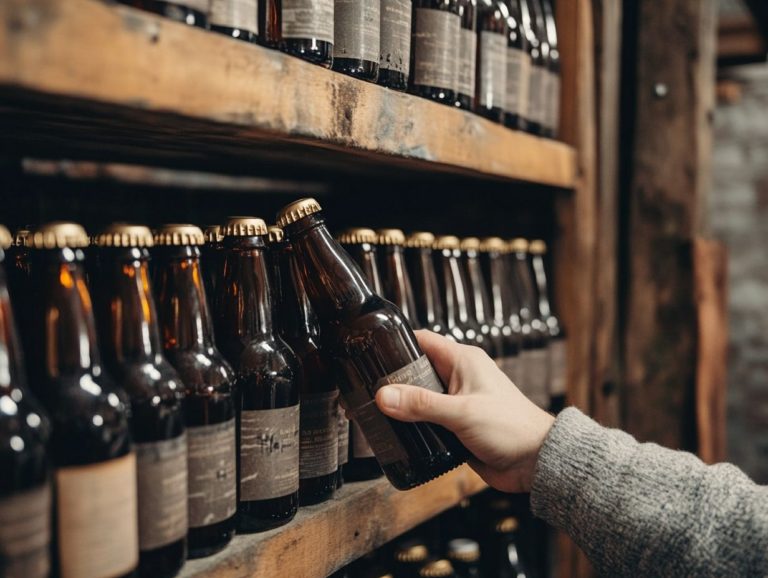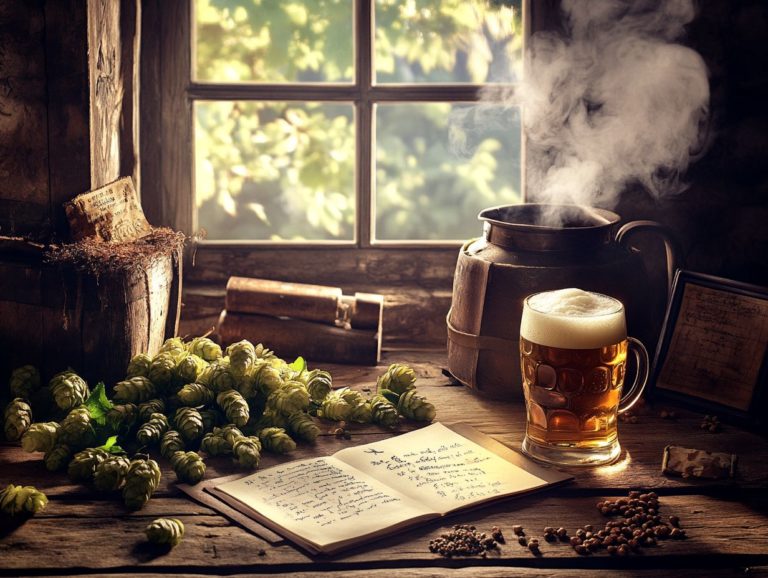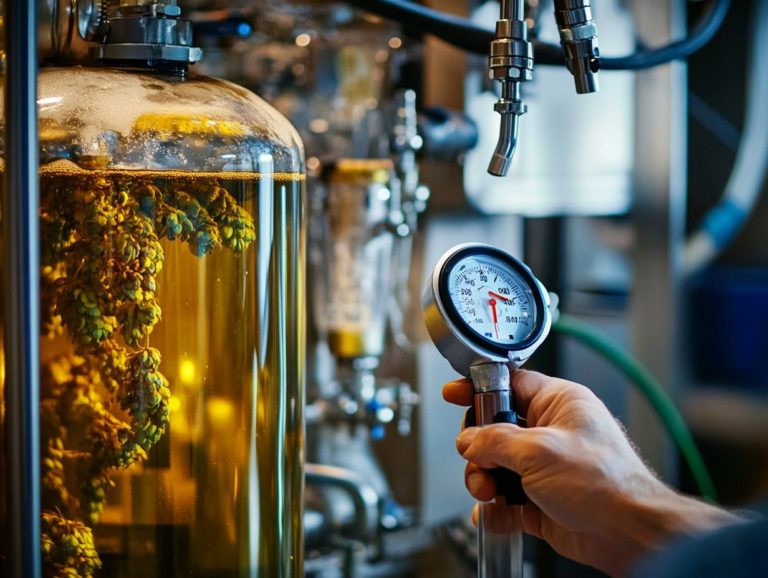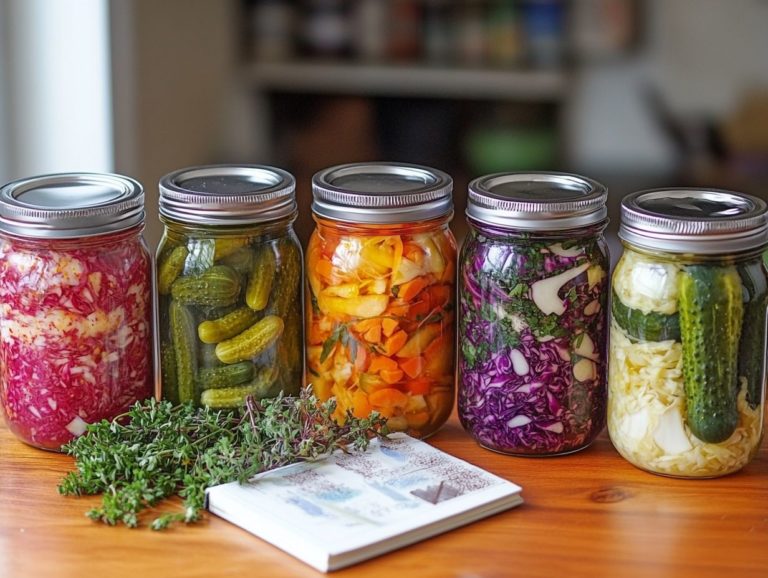The Best Practices for Home Brewing Techniques
Home brewing, often referred to as homebrew, transcends the label of a mere hobby; it invites you into a rewarding journey that embraces the art of crafting your very own beer.
Whether you find yourself as a curious beginner or a seasoned enthusiast, this guide is designed to navigate you through every essential aspect of the brewing process, including valuable brewing tips.
From grasping the fundamentals of brewing to delving into the vital equipment and ingredients like fresh ingredients, everything you need will be thoroughly covered.
You’ll also discover invaluable tips for troubleshooting common challenges, maintaining beer quality, and a selection of creative homebrew recipes to inspire your brewing adventures.
Prepare to unleash your inner brew master and embark on this exciting culinary quest!
Contents
- Key Takeaways:
- What is Home Brewing?
- Why Brew at Home?
- What Are the Benefits of Home Brewing?
- What Equipment Do You Need for Home Brewing?
- What Are the Essential Tools for Home Brewing?
- What Are the Optional Tools for Home Brewing?
- What Ingredients Are Needed for Home Brewing?
- What Are the Basic Ingredients for Home Brewing?
- Home Brewing: A Comprehensive Guide
- Home Brewing Guide
- Infection in Home-Brewed Beer
- How to Store and Serve Home-Brewed Beer?
- What Are Some Popular Home Brewing Recipes?
- Frequently Asked Questions
- What are the best practices for home brewing techniques?
- How can I ensure I am using fresh ingredients for my home brewed beer?
- Why is proper sanitation important in home brewing?
- What are the benefits of following recipe instructions in home brewing?
- How does fermentation temperature affect home brewed beer?
- What is the role of water in home brewing?
Key Takeaways:
What is Home Brewing?
Home brewing is your gateway to the exquisite art and science of producing beer on a smaller scale, typically for your own enjoyment. This delightful journey involves carefully selecting fresh ingredients, mastering the nuances of fermentation techniques, and grasping the brewing chemistry and brewing variables that determine the quality of your beer.
As an enthusiast, you can dive into various brewing styles, from classic ales to cutting-edge craft beers, while immersing yourself in a vibrant community that shares your brewing passion.
Influential figures like Charlie Papazian and the authors of iconic texts such as *The Joy of Homebrewing* and Randy Mosher’s *Radical Brewing* have motivated countless individuals, including you, to embark on your own brewing adventures, transforming this craft into a cherished hobby across the globe.
Why Brew at Home?
Brewing at home presents a wealth of advantages for beer enthusiasts like you, granting the ability to craft unique brews that reflect your personal taste preferences. This endeavor not only allows for creativity and experimentation but also fosters a deeper appreciation for both the quality of beer and the intricacies of the brewing process.
You may find joy in sourcing fresh ingredients and perfecting your skills through recipe development and various brewing techniques. Additionally, engaging in homebrew competitions can inspire you to push your limits and connect with a broader community that shares your passion.
What Are the Benefits of Home Brewing?
The benefits of home brewing are truly remarkable. It offers you the joy of crafting personalized recipes and a deeper understanding of the fermentation process.
As a home brewer, you ll acquire invaluable brewing experience. This allows you to fine-tune recipes to match your tastes while mastering various techniques and equipment knowledge.
Emphasizing sanitary practices during the brewing process is essential. It safeguards against fermentation flaws and elevates the quality of your beer, making the entire experience all the more rewarding.
This journey ignites your creativity. It opens the door to exploring a variety of styles, from IPAs to stouts and lagers, each inviting you to experiment with different hops and grains.
Imagine infusing your brews with unique adjuncts like fruits or spices to create something extraordinary for your next gathering! Tailor each batch for your personal palate or for seasonal celebrations.
Don t forget to use a yeast starter to ensure yeast health and vigor.
As you navigate the intricacies of fermentation temperature and timing, you ll enhance your skills. You will discover how even minor adjustments can dramatically influence the final product.
The knowledge you gain through trial and error fosters a profound respect for the brewing craft. Each successful batch transforms into a personal triumph.
Effective wort chilling and oxidation prevention are key steps in this process.
Ultimately, home brewing cultivates a sense of community. You can share your creations, tips, and experiences with fellow enthusiasts, further enriching the vibrant brewing landscape.
What Equipment Do You Need for Home Brewing?
Equipping yourself for home brewing is essential for ensuring a smooth and successful brewing journey. You’ll need a range of brewing equipment, including brewing pots for boiling wort, fermentation vessels like carboys, and an auto-siphon.
An auto-siphon allows you to transfer beer while minimizing oxygen exposure. Familiarizing yourself with the various tools at your disposal and understanding how each one contributes to the brewing process can significantly enhance your experience.
Stay informed about the latest brewing innovations to optimize your setup and techniques, leading to even greater results.
What Are the Essential Tools for Home Brewing?
Essential tools for home brewing include a selection of specialized equipment that guarantees a successful brewing experience. You’ll find that key items such as fermentation vessels, a blow-off tube for managing CO2 buildup, and a yeast starter to promote yeast vitality are crucial for achieving the fermentation results you desire.
Carboy handles can also make the process easier and safer. A beer paddle for stirring the wort and tools for accurately measuring and controlling temperature are also vital for producing high-quality brews.
Using a reliable hydrometer is critical. It allows you to monitor the specific gravity of the wort, which is important for determining alcohol content and ensuring that fermentation is progressing as it should.
A siphon hose is equally essential for transferring your beer without introducing unwanted sediment or oxygen, preserving both clarity and flavor integrity. Following a well-planned hop schedule also aids in achieving the desired bitterness and aroma.
Don t overlook sanitization tools. A spray bottle filled with a no-rinse sanitizer is necessary for keeping your equipment free from contaminants, crucial for crafting great-tasting beer.
Regular carboy cleaning is also essential for maintaining cleanliness and preventing off-flavors. Each of these tools plays a significant role in creating a smoother brewing experience, giving you the power to craft your brews with the precision and care they deserve.
Ready to embark on your brewing adventure? Gather your equipment and let the creativity flow!
What Are the Optional Tools for Home Brewing?
While essential tools lay the groundwork for your home brewing setup, optional tools can significantly elevate both your brewing experience and the final outcome. Integrate brewing software to streamline your process and keep your recipes organized. A thoughtful selection of brew kettles and the adoption of innovative brewing techniques can truly enhance the quality of the beer you produce.
Join a brewing podcast to stay updated on the latest trends and tips. Using hydrometers and refractometers will aid you in monitoring the specific gravity and sugar content two crucial elements for achieving the flavor profiles you desire. Investing in fermentation temperature control devices can dramatically enhance consistency and ward off off-flavors, which is often an overlooked aspect of brewing.
Proper yeast pitching rates can also ensure a healthy and vigorous fermentation process. Employ bottle conditioning tools to achieve optimal carbonation levels, further improving the overall taste of your brew. All these enhancements not only lead to superior quality but also make your brewing journey more enjoyable.
Remember that careful documentation is key; it allows you to track changes and improvements over time, ensuring that your brewing skills continue to flourish.
What Ingredients Are Needed for Home Brewing?
Choosing the right ingredients is essential in the home brewing process, significantly impacting both the flavor and quality of your final product. By opting for fresh ingredients such as high-quality malt, thoughtfully selected hop varieties, and a robust yeast pitch you’re on the path to brewing amazing beer. Understanding the nuances of water pressure can also influence the final outcome.
Grasping the importance of a mixture of grains and their influence on flavor profiles is essential for aspiring home brewers seeking to truly master the art of brewing and overcome brewing challenges.
What Are the Basic Ingredients for Home Brewing?
The basic ingredients for home brewing are malted grains, hops, yeast, and water. Each of these ingredients plays a pivotal role in the brewing chemistry and fermentation process, and understanding their functions is key for you, the aspiring home brewer, who seeks to craft a truly exceptional beer. Leveraging reliable brewing resources can provide you with the necessary knowledge and skills.
The malted grains, primarily barley, undergo a germination process that develops the starches necessary for fermentable sugars. These sugars are then transformed by the yeast into alcohol during fermentation, creating the very essence of your brew. On the other hand, hops the flower clusters of the hop plant do more than just add bitterness to balance the malt’s sweetness; they also contribute aromatic qualities that enrich the overall profile of your beer.
Let s not overlook water. It s far from being just a filler; the mineral content in your water can significantly influence flavor, mouthfeel, and even the efficiency of the brewing process. Thus, it becomes a vital component in achieving the specific characteristics you desire in your beer. Effective brew day organization can further streamline your process and improve the end results.
Embrace the nuances of these ingredients, and you ll be well on your way to brewing excellence.
Home Brewing: A Comprehensive Guide
What Are the Steps for Home Brewing?
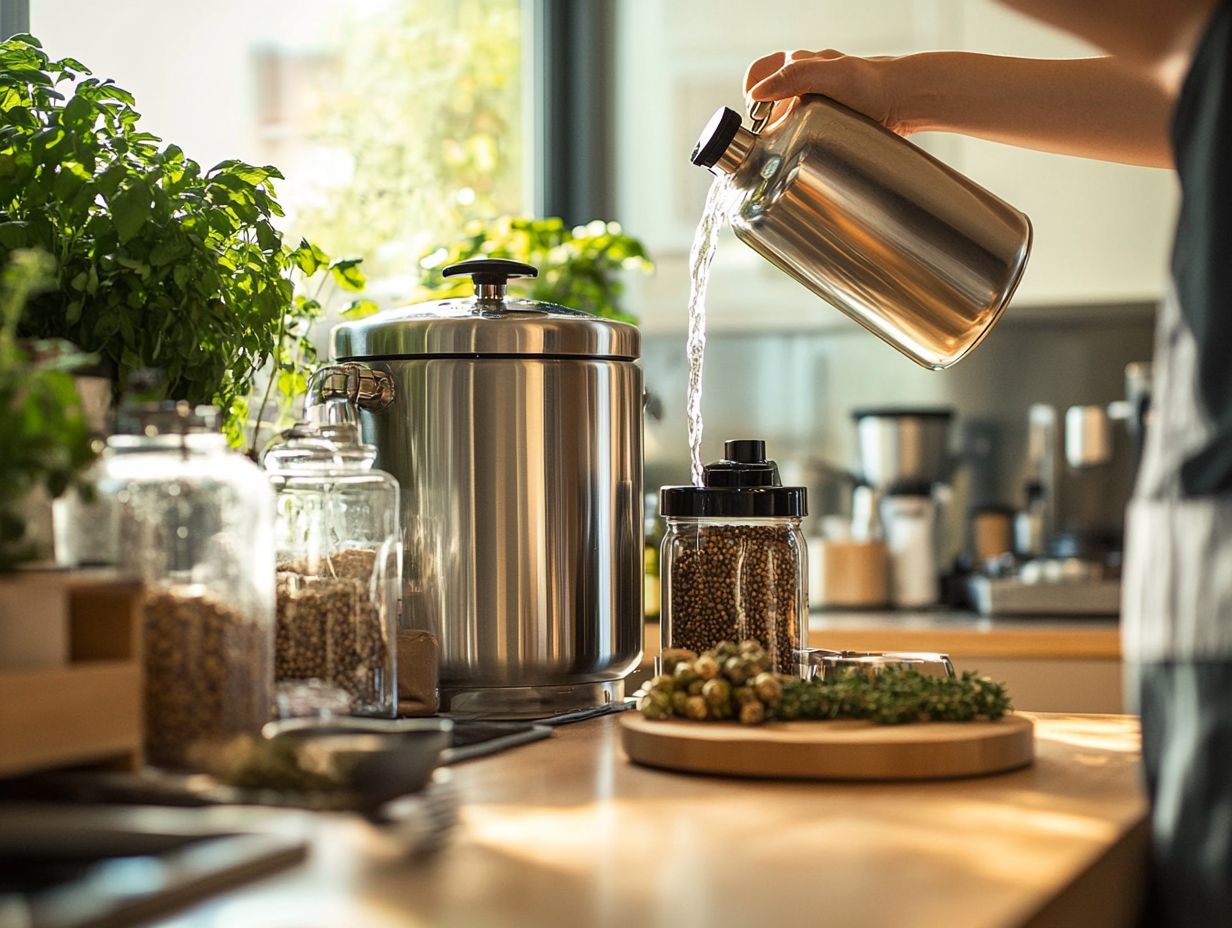
Ready to dive into the exciting world of home brewing? Here s how to ensure your brew day is a success!
Following each step meticulously can ensure a smoother brewing experience and higher quality beer. To get started, consider these five essential brewing techniques for beginners. From preparing the equipment to monitoring fermentation, each phase has its own set of requirements and best practices.
The home brewing process encompasses several crucial steps that, when executed with precision, can lead to a remarkably successful brew day and the creation of exceptional beer. Seeking brewing tips can also provide valuable insights for a more efficient process.
A well-structured brew day is vital. Start with the meticulous sanitization of equipment to eliminate any risks of fermentation flaws. Following this, you’ll prepare your ingredients.
The journey unfolds through mashing, boiling, wort chilling, and fermenting. Each stage demands your careful attention to detail and an awareness of the brewing challenges that may present themselves along the way. Leveraging brewing resources and brewing software can help you track and manage these stages effectively.
1. Sanitizing Equipment
Sanitizing your equipment is not just a step; it s the foundation of brewing great beer. It helps prevent fermentation flaws that could potentially ruin your batch of beer. Use the right cleaning solutions and methods to ensure that all your brewing tools and containers are completely free from contaminants before they touch the wort (the liquid extracted from the malted grains before fermentation) or your finished beer.
Utilizing a blow-off tube can help manage excess pressure during fermentation. These practices are crucial because even the smallest trace of bacteria can introduce undesirable flavors or lead to spoilage. It s not merely a matter of rinsing with water; savvy brewers often rely on various sanitizers, such as iodine-based solutions, chlorine dioxide, or peracetic acid, to guarantee a dependable level of cleanliness.
Methods like boiling, steam cleaning, and utilizing specialized sanitizing sprays offer additional assurance that your equipment remains free from harmful microorganisms. Ultimately, prioritizing sanitation is vital for a successful fermentation process, as it significantly impacts the quality and taste of your final brew.
2. Preparing the Ingredients
Preparing your ingredients is an art that requires careful selection and precise measurement. You’ll want to ensure you have the freshest ingredients on hand for the brewing process. This stage might involve crafting a hop schedule, determining precisely when to add hops during the boil, and making sure that your malt is milled just right. Ensure your yeast is at the perfect temperature before pitching.
Choosing quality malt is essential, as it not only impacts the sweetness of your beer but also contributes significantly to its color and aroma. Each type of malt offers its own unique flavors; for example, caramel malts bring a delightful toasty essence, while roasted malts infuse a dark, rich character. Pay attention to grain bills to balance these flavors effectively.
Hops play a crucial role in both bitterness and aroma, requiring meticulous planning to enhance the beer s profile at various stages. Keeping your yeast viable is vital for an optimal fermentation process, which is key to achieving the desired alcohol content and flavor balance. Integrating brewing techniques like creating a yeast starter can help maintain yeast health.
Every element in this process deserves your utmost attention, as their harmonious interplay will directly influence the taste and quality of your final product.
Now that you understand the steps, it’s time to start brewing your own beer! Gather your ingredients and unleash your creativity.
Mashing
Mashing is the art of steeping milled malt in hot water. This allows enzymes to convert starches into fermentable sugars, setting the foundation for your beer’s flavors.
To optimize mashing, aim for a temperature range of 148 F to 158 F, depending on the enzymes you want to activate. Alpha amylase thrives at higher temps, generating more dextrins (complex sugars that add body), while beta amylase excels at cooler temperatures, focusing on creating fermentable sugars.
The mash duration typically lasts between 60 to 90 minutes and is crucial for sugar extraction. By managing temperature and time, you enhance the efficiency of your brewing process.
Boiling
The boiling stage is essential for sterilizing the wort and extracting rich flavors from hops. Follow a hop schedule to achieve the perfect balance of bitterness, flavor, and aroma.
Timing is key. Early additions, within the first 60 minutes, impart essential bitterness. Late additions in the last 15 minutes maximize flavor and aroma, enriching your final product.
After boiling, use effective wort chilling techniques to prevent unwanted bacteria. This helps you reach the ideal pitching temperature for the yeast.
Fermentation
Fermentation is the pinnacle of your brewing journey. Yeast works its magic by converting sugars into alcohol and carbon dioxide. Maintaining yeast health is essential for a successful brew.
Temperature control is vital because most yeast strains thrive within a specific range. This encourages vigorous fermentation and avoids undesirable flavors.
An ideal pH level also nurtures yeast activity. Monitoring it can yield remarkable results, while tracking specific gravity readings (a measure of sugar content) offers insights into your brewing progress.
Regularly assess yeast viability and ensure nutrient availability to cultivate a flourishing fermentation environment. This leads to a beer that will delight your palate.
Bottling and Carbonation
6. Bottling and Carbonation
Bottling and carbonation represent the final steps in your home brewing journey. This stage transitions your beer from the fermentation stage to that delightful moment when it’s ready to drink.
It’s crucial to exercise caution during bottling to prevent oxygen exposure. This exposure can introduce unwanted flaws into your brew.
Using an auto-siphon can make the bottling process smoother and more efficient.
Thoroughly cleaning your bottles and caps ensures the integrity of your beer during this pivotal phase. Good carbonation techniques can improve the feel and taste of your beer.
Do not overlook the importance of carboy cleaning to ensure all your fermentation vessels are sanitized.
To begin, ensure that all your equipment is sanitized meticulously, as this prevents any unwanted bacteria from spoiling your batch.
When filling the bottles, consider using a siphon; this minimizes disturbance and preserves the beer’s integrity and carbonation level.
It’s equally important to leave adequate headspace the empty space at the top of the bottle for natural carbonation to occur without risking overflow.
Once sealed, store your bottles in a dark, warm place to foster carbonation development.
Monitoring these conditions is essential. Too much heat can lead to over-carbonation or off-flavors, while cooler temperatures might stall the process altogether.
By following these best practices, you’ll craft a clean, flavorful beer that impresses!
What Are Some Tips for Successful Home Brewing?
Seeking advice from renowned brewers like Charlie Papazian and referring to books like The Joy of Homebrewing can inspire new techniques and ideas.
Successful home brewing is a beautiful fusion of art and science. There are numerous tips and techniques that can elevate the quality of your beer.
Beer quality often reflects the brewer’s dedication to both recipe development and adherence to brewing techniques.
To start, focus on maintaining yeast health, as it is crucial for optimal fermentation.
Implement strategies to prevent oxidation to safeguard the flavor of your brew.
Mastering various brewing techniques and refining your process will only enhance your skills over time.
Documenting your brewing process can also help in making necessary recipe adjustments.
By adopting these practices, you can achieve more consistent and delightful results in every batch.
What Are Some Solutions for Common Home Brewing Problems?
Resources like John Palmer’s How to Brew offer comprehensive guidance on addressing various brewing issues.
Troubleshooting common home brewing problems is a critical skill for you as a brewer, empowering you to spot and rectify issues that may impact the quality of your beer.
By familiarizing yourself with typical fermentation flaws, such as off-flavors and cloudiness, you can effectively pinpoint problems related to yeast pitching and other brewing challenges.
Engaging with the brewing community can provide additional insights for troubleshooting.
Utilizing both brewing resources and your own experience will prove invaluable in overcoming these hurdles, ensuring that each batch you create is nothing short of exceptional.
Referencing brewing software can help track variables and improve consistency.
1. Off-flavors
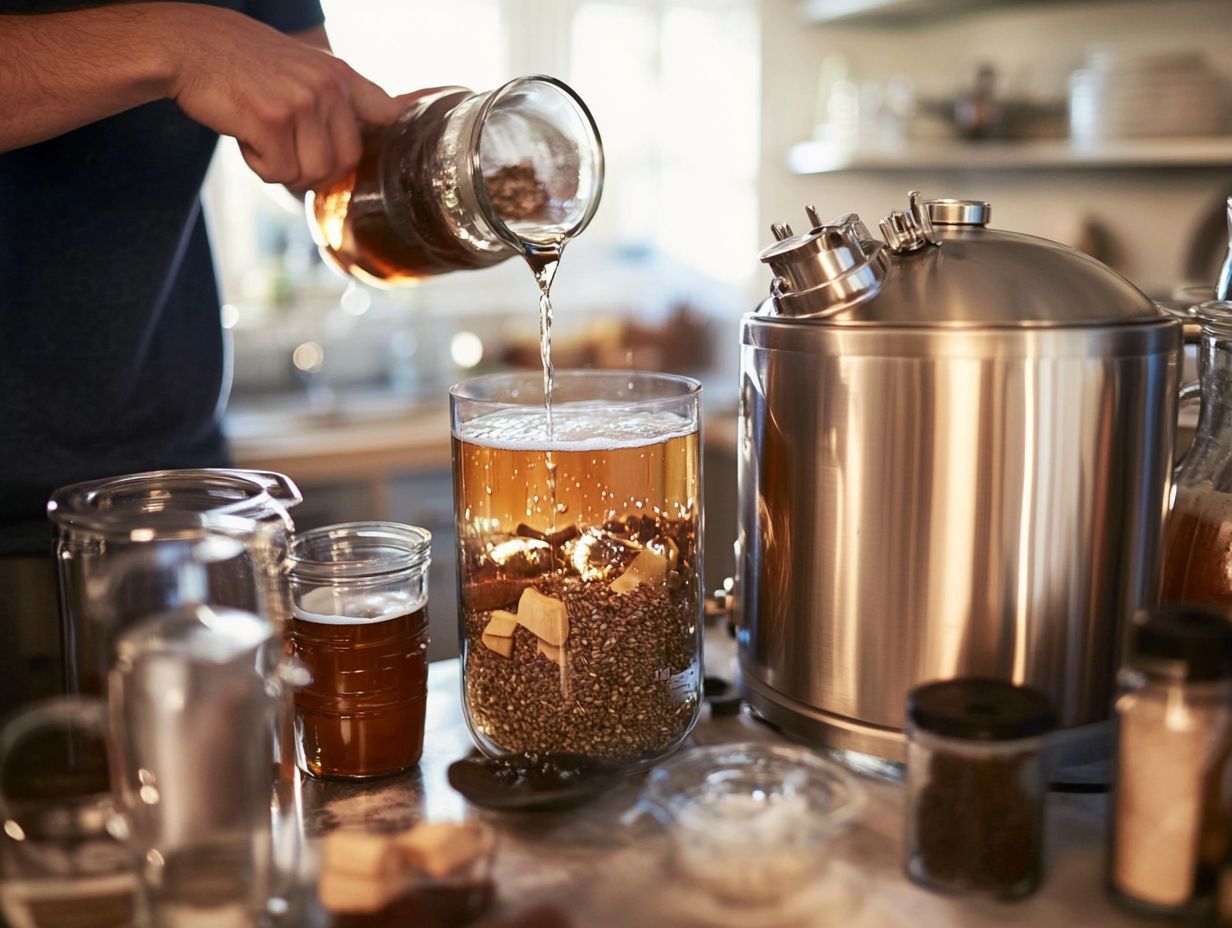
Off-flavors in your home-brewed beer can be quite the vexing dilemma, often stemming from improper fermentation practices or pesky infections. Several key factors contribute to these unwanted flavors, including yeast health, fermentation temperature, and sanitation practices. Properly adding yeast and using fresh ingredients can also play a significant role. Use the right brewing techniques to minimize off-flavors and enhance your beer experience!
The balance of flavors is paramount, and even the slightest misstep in your process can result in undesirable compounds like diacetyl or acetaldehyde. For example, if fermentation temperatures climb too high, it can put your yeast under stress, resulting in off-flavors that remind you of butter or green apples. Effective temperature control and knowledge of brewing chemistry can help in managing these issues.
To tackle these challenges, keep a close eye on your fermentation by using temperature control methods such as fermentation chambers or temperature wraps. Consider using a blow-off tube to manage active fermentations and reduce the risk of fermentation flaws.
Maintaining stringent sanitation standards throughout the brewing process is crucial to thwart wild yeast or bacteria from spoiling your hard work. By understanding these common pitfalls and consulting quick tips for efficient home brewing, you can refine your brewing practices and achieve the delightful flavor profiles you aspire to create.
2. Cloudy Beer
Cloudy beer can truly diminish the allure and overall enjoyment of your brew. This haze often results from issues encountered during fermentation or inadequate cleaning practices. Factors such as improper wort chilling, carboy cleaning, or fermentation temperatures can lead to unwanted cloudiness. By understanding how to address these challenges, you can achieve a clearer, more visually enticing beer.
To enhance clarity, it’s essential for you, as a brewer, to prioritize sanitation and temperature control. Thoroughly cleaning and sanitizing all equipment before use significantly reduces the risk of introducing unwanted contaminants. Additionally, following best practices for home brewing safety and incorporating brewing tips from seasoned brewers can also be beneficial.
Incorporating fining agents like gelatin or Irish moss during the brewing process can effectively precipitate haze-forming proteins, enabling them to settle out of the final product. Engaging in proper cold conditioning or lagering post-fermentation not only improves clarity but also enhances flavor stability.
By implementing these techniques, you can greatly reduce the chances of producing hazy brews, offering a more gratifying experience for those who appreciate the visual elegance of a crisp, clear beer. Remember, the importance of documentation cannot be overstated in improving your brewing consistency.
3. Low Carbonation
Low carbonation in your home-brewed beer can stem from common culprits, such as insufficient yeast added during bottling or inadequate sugar levels for carbonation. By recognizing the signs of low carbonation and grasping the significance of proper bottling techniques, you can effectively remedy this issue and achieve the desired effervescence in your brew. Keeping a yeast starter ready can often help in boosting carbonation levels.
Several factors may contribute to this problem. For instance, if you re using an old or inactive yeast strain, it can hinder the fermentation process, while inadequate priming sugar will likely lead to underwhelming fizz levels. Using an auto-siphon can help minimize oxygen exposure during bottling, promoting better carbonation.
To tackle these concerns, it s essential to measure the correct amount of priming sugar based on both the volume of your beer and your target carbonation level. Ensuring that the yeast is healthy and active before bottling can significantly enhance your carbonation outcomes.
Don t hesitate to seek advice from seasoned brewers or consult reliable reference guides; these resources can provide valuable insights into effective bottling practices that will help you perfect the carbonation of your homebrew. Consider joining a brewing community to exchange ideas and learn from others experiences.
Home Brewing Guide
Infection in Home-Brewed Beer
Infection in your home-brewed beer can be a serious concern, often stemming from poor hygiene practices during the brewing process. It s essential to identify signs of infection like unusual flavors or off-putting aromas to understand how to prevent it in your future batches.
By implementing rigorous cleaning processes and staying vigilant about potential brewing challenges, such as proper carboy fermentation management (the fermentation vessel where beer is brewed), you can significantly reduce the risk of infection.
To tackle this issue effectively, you must recognize the importance of cleanliness in brewing. Sanitizing all your equipment, from fermenters to bottles and kegging systems, is absolutely paramount before and after each use. This ensures that any lingering microbes are eradicated and won t spoil your hard work.
Utilizing heat or chemical sanitizers, along with conducting regular checks on your brewing environment, can help you spot potential trouble areas. It s also wise for you to educate yourself about the behaviors of yeast and bacteria, as this knowledge is essential for discerning acceptable fermentation results from those that are not.
Keeping up with brewing innovations can also give you an edge in maintaining a hygienic brewing setup. By prioritizing sanitation, you not only protect the integrity of your beer but also enhance your overall enjoyment of the final product!
How to Store and Serve Home-Brewed Beer?
Storing and serving your home-brewed beer correctly is crucial for preserving its flavor and quality, allowing you to fully appreciate the effort you poured into the brewing process.
Employing proper storage techniques, like maintaining the ideal temperature and shielding your beer from light, can notably extend its shelf life. Understanding serving temperature is essential, and choosing the right glassware can truly elevate the experience for both you and your guests!
Understanding brewing variables is key to optimizing storage conditions.
1. Proper Storage Techniques
Implementing proper storage techniques is crucial for maintaining the quality and freshness of your home-brewed beer. Key practices include storing your bottles upright to prevent sediment disturbance and keeping them in a cool, dark place to minimize oxidation (when beer comes into contact with air, it can spoil) and light exposure, both of which can negatively impact flavors.
Using carboy handles when moving bottles can also prevent unwanted agitation. These methods not only help preserve the unique characteristics of each brew but also elevate your overall drinking experience.
It’s wise to avoid temperature fluctuations, as they can lead to off-flavors and spoilage. Using airtight containers further protects your beer from unwanted elements like oxygen, which can cause staling. Consider implementing oxidation prevention techniques to prolong freshness!
Choosing the right storage location is equally important; a dedicated beer fridge or a temperature-controlled storage unit can make a significant difference. By following these effective storage strategies, you can enjoy your creations at their best quality, maximizing enjoyment with every pour!
Also, explore brewing software options to keep track of your storage conditions and inventory.
2. Serving Temperature and Glassware
Serving temperature and the right glassware are essential for enhancing the flavors and overall enjoyment of your home-brewed beer. Different beer styles thrive at specific serving temperatures, and selecting the appropriate glass can elevate the beer s aroma and appearance, transforming your drinking experience!
For instance, lagers are at their best when served chilled, as the cooler temperatures help maintain their crispness while filtering out any harsh flavors. On the other hand, darker ales or stouts benefit from being served slightly warmer, allowing their rich, complex aromas to unfold and reveal delightful notes of chocolate, coffee, or caramel.
The choice of glassware is just as crucial; a tulip glass can beautifully concentrate hop aromas, while a pint glass is perfect for savoring the visual allure of a bright golden ale. By paying attention to these details, you can truly appreciate the artistry behind each brew, turning every sip into a memorable experience!
What s your favorite way to store your home-brewed beer?
What Are Some Popular Home Brewing Recipes?
Popular home brewing recipes encompass a diverse array of styles, inviting you to explore a world of flavors and techniques. Consider the crisp bitterness of an IPA, the rich, dark notes of a stout, or the refreshing qualities of a wheat beer each offering a distinctive tasting experience. Utilize brewing software like BeerSmith for precise recipe development and adjustments.
Every recipe comes with its own set of challenges and opportunities for development, showcasing the wide-ranging brewing styles that enthusiasts hold dear. Embrace the art of brewing, and let your creativity flow as you craft your next masterpiece.
1. IPA
India Pale Ales (IPAs) are celebrated for their bold hop character, making them a staple choice for discerning home brewers. The intricate nature of an IPA opens the door to various hop varieties, each imparting distinct flavors and aromas. You can experiment with recipe tweaks to achieve that perfect taste. Utilize brewing resources like The Joy of Homebrewing by Charlie Papazian for in-depth guidance and tips.
Consider the options available: Cascade, Citra, and Simcoe. The choice of hops becomes a signature element of your final brew. For instance, Cascade hops bring delightful floral and citrus notes, while Citra is renowned for its vibrant grapefruit and tropical fruit profiles. Experimenting with when to add hops during brewing can help you achieve a unique taste.
By fine-tuning hop additions throughout the brewing process whether you choose dry hopping, late hopping, or whirlpool hopping you can elevate aroma and flavor intensity. Adjusting the malt backbone can also help balance the bitterness typical of an IPA, leading to a smoother, more enjoyable drinking experience. Don’t forget to refer to brewing podcasts and forums for the latest trends and tips.
The endless possibilities of IPAs spark excitement and creativity in every brewer!
2. Stout
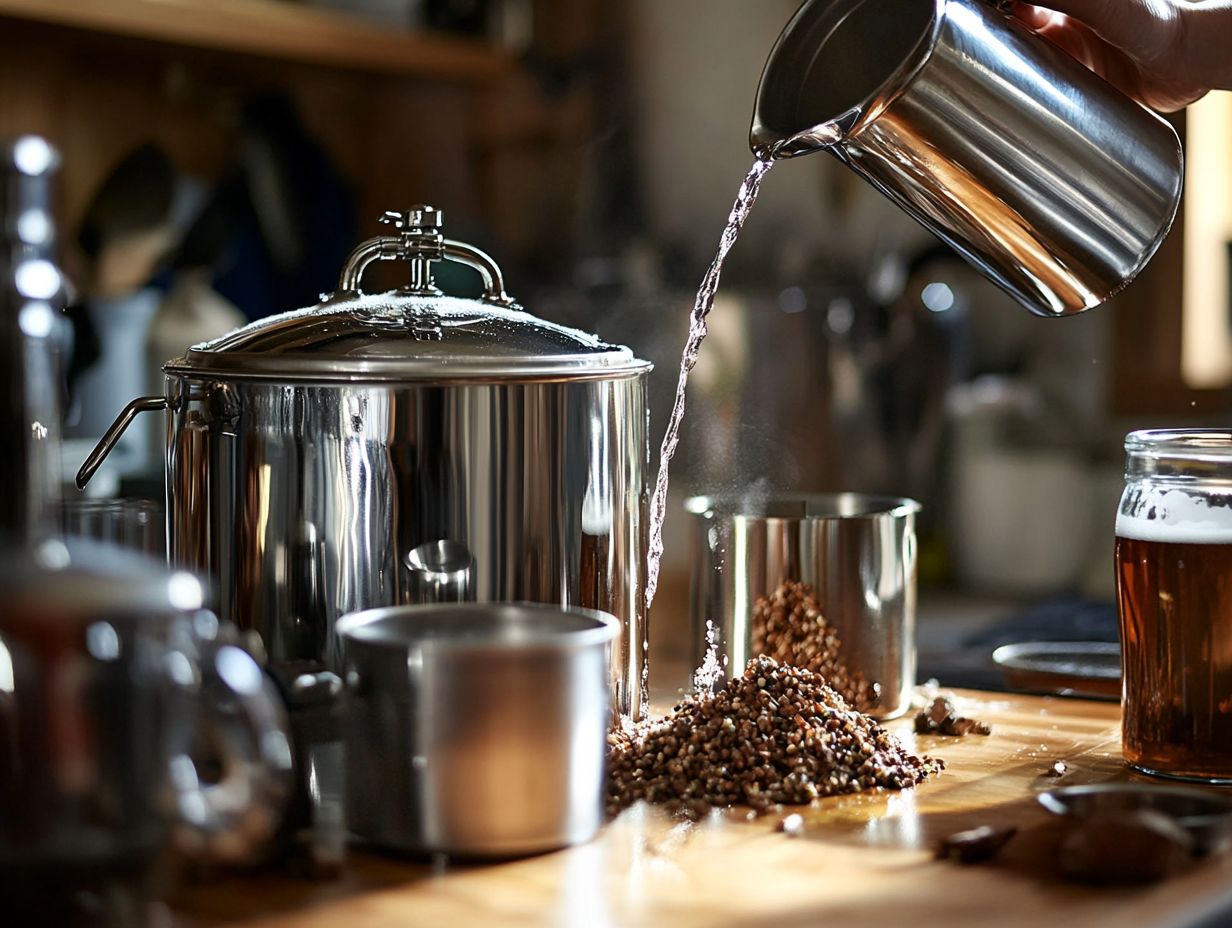
Stouts are revered for their rich, dark profiles, often showcasing roasted malt flavors that bring depth and complexity that s hard to resist. When you dive into brewing stouts, you’ll find that specific grain bills are essential; they contribute to the characteristic sweetness and mouthfeel that make these brews a rewarding challenge to perfect at home.
But it s not just about the malts selecting the right hops is also crucial, as they create a harmonious balance between sweetness and subtle bitterness. Many brewers enjoy getting creative with extra ingredients like lactose or coffee, enhancing the flavor profile and giving rise to delightful variations like milk stouts or oatmeal stouts.
Then there s fermentation, a significant player in the game. The choice of yeast strains will influence the final taste and affect the mouthfeel and aroma of your stout. Remember, temperature control during fermentation is vital; it can greatly impact the esters and phenols that develop, adding even more layers of complexity to your creation.
This intricate dance of ingredients and techniques highlights the artistry and science behind crafting a memorable stout, making it an enticing pursuit for both budding brewers and seasoned craft beer aficionados.
3. Wheat Beer
Wheat beers are celebrated for their refreshing qualities and distinctive cloudy appearance, typically crafted with a generous portion of wheat alongside barley. The fermentation process for these beers places a strong emphasis on yeast health, which is essential for developing their unique flavors and aromas, making them a delightful option for those who enjoy home brewing.
These unique brews often showcase a light body with subtle fruity or spicy notes, largely influenced by the specific yeast strains employed. Whether you’re an amateur or a seasoned professional, understanding the importance of maintaining yeast health can profoundly impact fermentation outcomes, leading to a more complex and balanced beer.
Techniques like proper oxygenation and controlling fermentation temperatures are vital for ensuring that the yeast remains active and vibrant.
The bready sweetness derived from the wheat malt enhances the overall mouthfeel, creating a creamy texture that beautifully complements a variety of food pairings. Don t miss out on the satisfaction of pouring your own perfectly brewed wheat beer!
4. Pale Ale
Pale ales are an exceptional choice for home brewers like you, celebrated for their balanced flavors and approachable bitterness. With a myriad of hop varieties at your disposal, you have the freedom to experiment with distinct recipes, allowing your creativity to flourish as you develop your own unique versions of this classic style.
The brewing process for pale ales begins with selecting high-quality malt typically pale malt which forms a solid foundation of sweetness and body in your brew. Many brewers, including you, often incorporate crystal malt to add delightful caramel-like flavors and enhance the overall color of the beer.
Start by conducting a mash to convert those starches into sugars. Next, you ll boil the wort, which is the liquid extracted from the mash that contains sugars, introducing hops that impart characteristic citrus, floral, or pine notes. Keep in mind that the timing and quantity of hops you add during the boil can significantly influence the aroma and bitterness of your beer.
After cooling the wort, you ll enter the fermentation stage. Choose specific yeast strains that beautifully complement the flavor profile you’ve crafted. Your careful selection of ingredients and precise brewing techniques will ultimately contribute to the diverse and inviting flavors found in the pale ales you create.
5. Porter
Porters offer a luxurious experience, presenting a rich tapestry of flavors thanks to their roasted malts, which contribute deep and complex notes. As a brewer, you ll find that your choice of grain bills can dramatically shape the taste and mouthfeel of your final product, making the pursuit of this style an incredibly rewarding journey.
When choosing your ingredients, consider a blend of base malts and specialty grains, such as chocolate or crystal malts, to achieve that signature depth for which porters are known. While the malt-forward profile means hops take a backseat, their selection remains crucial for balancing the overall flavor harmony.
Don’t overlook fermentation; opt for yeast strains that enhance those malt characteristics without overshadowing them. This ensures you achieve the desired aroma and finish. By paying keen attention to detail throughout this entire brewing process, you can create a delightful representation of the porter style that will impress both you and those fortunate enough to sample your creation.
Frequently Asked Questions
What are the best practices for home brewing techniques?
The best practices include using fresh ingredients, properly sanitizing equipment, following recipe instructions, maintaining proper fermentation temperatures, and using quality water.
How can I ensure I am using fresh ingredients for my home brewed beer?
To ensure freshness, purchase ingredients from a reputable supplier and check expiration dates. It is also recommended to use whole ingredients instead of pre-packaged kits.
Why is proper sanitation important in home brewing?
Pro tip: Proper sanitation is your best defense against off-flavors! Sanitation is crucial to prevent contamination and off-flavors in the finished product. Make sure to thoroughly clean and sanitize all equipment before and after use.
What are the benefits of following recipe instructions in home brewing?
Following recipe instructions allows for consistency and accuracy in the brewing process, ensuring a well-balanced and high-quality final product.
How does fermentation temperature affect home brewed beer?
The fermentation temperature significantly influences the flavor and aroma of your beer. To achieve the best results, keep it within the recommended range for the specific type of beer being brewed.
What is the role of water in home brewing?
Water is a key ingredient and can greatly affect the taste of your final product. It is recommended to use filtered or spring water with balanced mineral content for optimal results.

